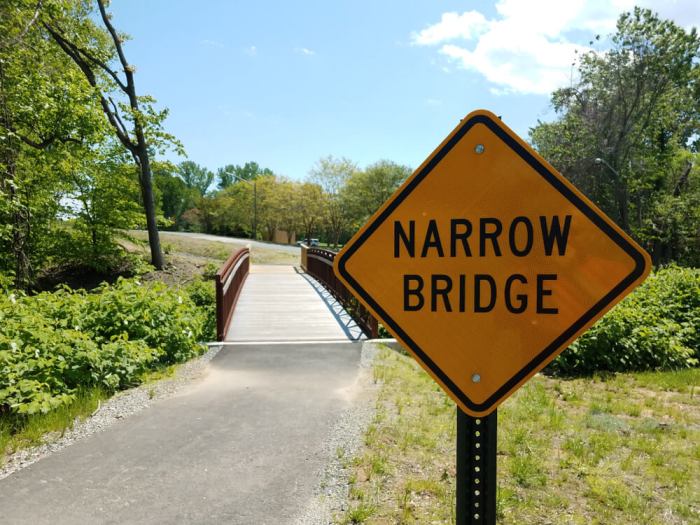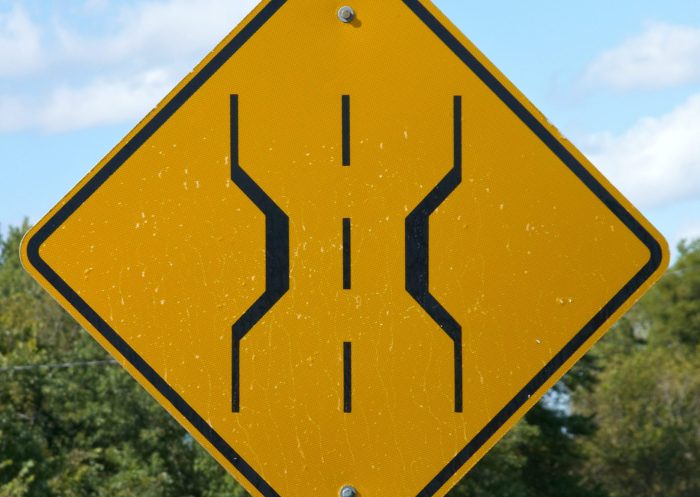Delving into the realm of “que significa la señal narrow bridge,” this exploration embarks on a comprehensive journey, unraveling the intricate meaning and profound implications of these enigmatic road signs. As we navigate the complexities of narrow bridges, their diverse types, safety considerations, engineering challenges, and historical significance, a deeper understanding emerges, guiding us toward safer and more informed encounters with these unique structures.
From their structural designs to their cultural heritage, narrow bridges stand as testaments to human ingenuity and the delicate balance between safety and accessibility. Their presence on our roadways serves as a constant reminder of the need for vigilance and respect, as we traverse these narrow passages that connect communities and shape our understanding of the world around us.
Meaning and Definition of “Narrow Bridge”
A narrow bridge is a structure that spans a physical obstacle, such as a river or ravine, and has a width that is significantly narrower than its length. The narrowness of the bridge imposes specific constraints on its design, construction, and use.
Narrow bridges are often found in historic settings, where they may have been built with limited resources or to fit within existing infrastructure. They can also be found in modern settings, where they are used to cross narrow waterways or to provide access to remote areas.
Types and Characteristics of Narrow Bridges
There are several different types of narrow bridges, each with its own unique design and characteristics.
- Beam bridgesare the most common type of narrow bridge. They consist of a single beam that is supported by piers or abutments at each end.
- Arch bridgesare made up of a curved arch that supports the weight of the bridge. They are often used for crossing wide spans.
- Suspension bridgesare made up of a series of cables that are suspended between two towers. The cables support the weight of the bridge deck.
Narrow bridges typically have a width of less than 20 feet (6 meters). They may be made of wood, steel, or concrete.
Safety Considerations for Narrow Bridges

Narrow bridges can pose a safety hazard for vehicles and pedestrians. The narrow width of the bridge can make it difficult for vehicles to pass each other, and the lack of shoulders can make it difficult for pedestrians to walk safely.
- Vehiclesshould slow down and be prepared to stop when crossing a narrow bridge.
- Pedestriansshould walk on the shoulder of the bridge, if possible. If there is no shoulder, they should walk on the side of the bridge facing traffic.
In some cases, it may be necessary to install traffic signals or other safety measures to improve the safety of a narrow bridge.
Engineering Challenges in Narrow Bridge Construction

The construction of narrow bridges presents a number of unique engineering challenges.
- The narrow width of the bridge can make it difficult to provide adequate support for the structure.
- The lack of shoulders can make it difficult for vehicles to pass each other safely.
- The bridge may be subject to high winds, which can cause it to sway or collapse.
Engineers must carefully consider all of these factors when designing and constructing a narrow bridge.
Historical and Cultural Significance of Narrow Bridges

Narrow bridges have played an important role in history and culture. They have been used to connect communities, facilitate trade, and provide access to remote areas.
Many narrow bridges are considered to be historical landmarks. They may be protected by law and may be eligible for funding for preservation.
FAQ Compilation: Que Significa La Señal Narrow Bridge
What is the primary purpose of a “narrow bridge” sign?
To alert drivers to an upcoming bridge with a width that may be narrower than standard, requiring extra caution and reduced speed.
What are some common safety concerns associated with narrow bridges?
Limited visibility, reduced maneuverability, increased risk of collisions, and potential for rollovers due to uneven surfaces or high winds.
How do engineers design narrow bridges to ensure structural integrity?
By employing techniques such as reinforced concrete, steel girders, and innovative support systems that distribute weight evenly and enhance stability.